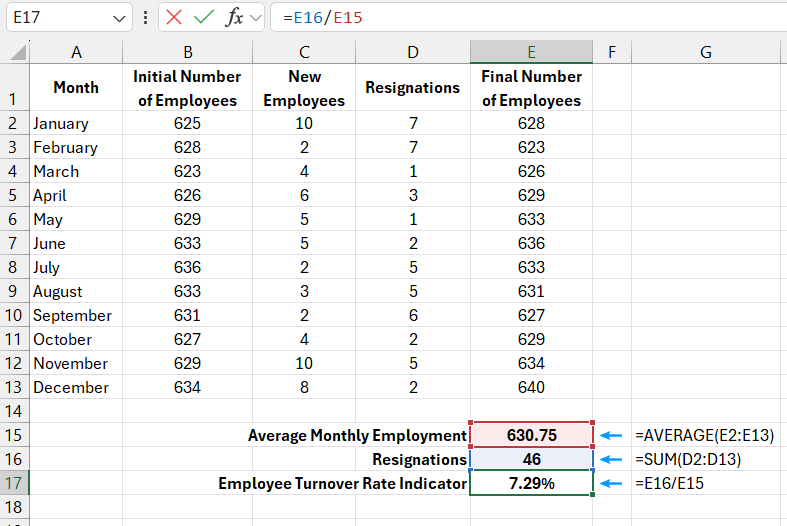How to Calculate Employee Turnover Rate Using Excel Formulas
Employee turnover rate measures how effectively a company retains its valuable employees. What is meant by employee turnover? A high turnover rate indicates that a company either hires unfit workers or fails to retain them. Essentially, high staff turnover may result from poor working conditions, lack of advancement opportunities, below-average pay, etc. Employee churn poses a significant risk for companies, especially with the external rotation of essential line workers. Often, employee departures occur due to contract expiration or voluntary resignation.
How to Calculate Employee Turnover Percentage Using Excel Formulas
The chart below displays employee turnover data for a company over 12 months. The number of employees at the beginning of the month is adjusted by adding new hires and subtracting those who left the company.
Source Data Table:
| Month | Initial Number of Employees | New Employees | Resignations | Final Number of Employees |
| January | 625 | 10 | 7 | 628 |
| February | 628 | 2 | 7 | 623 |
| March | 623 | 4 | 1 | 626 |
| April | 626 | 6 | 3 | 629 |
| May | 629 | 5 | 1 | 633 |
| June | 633 | 5 | 2 | 636 |
| July | 636 | 2 | 5 | 633 |
| August | 633 | 3 | 5 | 631 |
| September | 631 | 2 | 6 | 627 |
| October | 627 | 4 | 2 | 629 |
| November | 629 | 10 | 5 | 634 |
| December | 634 | 8 | 2 | 640 |
| Average Monthly Employment | 630.75 | |||
| Resignations | 46 | |||
| Employee Turnover Rate Indicator | 7.29% | |||
This method calculates the final number of employees:

Download an example of the employee turnover rate formula in Excel 
The turnover rate is the ratio of the number of employees who left the company to the average number of employees hired throughout the month. The AVERAGE function is used to calculate the average number of employees for the entire month. The total number of resignations is summed up using the SUM function (СУММ) and divided by the average number of employees.
The results of these calculations can be compared to the industry averages or companies of a similar profile. Turnover rates vary by industry, so simply comparing this metric to previous results could lead to incorrect decisions. Premature measures, such as internal employee rotation programs, may also be misapplied. While it’s not always necessary to calculate turnover rates for 12 months, doing so can smooth out seasonal fluctuations in resignations that might otherwise skew the results.
